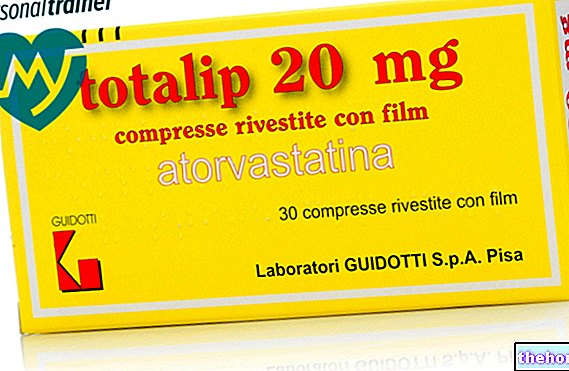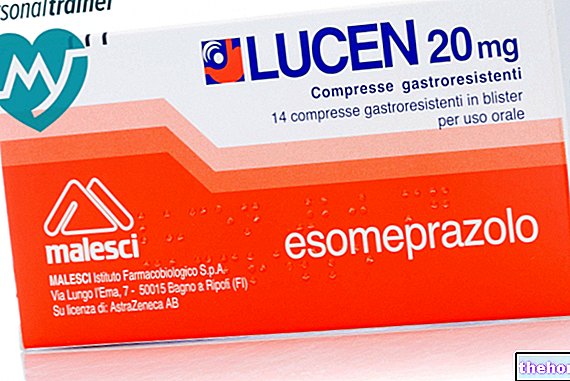Active ingredients: Calcium carbonate, Cholecalciferol
OROTRE 500 mg + 400 IU tablets
Indications Why is Orotre used? What is it for?
OROTRE contains cholecalciferol, better known as vitamin D, and calcium carbonate, substances that are important for bone formation.
OROTRE is indicated:
- in the elderly for the treatment of calcium and vitamin D deficiency.
- in patients of all ages who are at risk of calcium and vitamin D deficiency, as an adjunct treatment of bone fragility (osteoporosis).
Talk to your doctor if you don't feel better or if you feel worse.
Contraindications When Orotre should not be used
Do not take OROTRE
- If you are allergic to calcium carbonate, cholecalciferol or any of the other ingredients of this medicine.
- If you suffer from increased levels of calcium in your blood or urine, especially if you have been immobilized for a long time.
- If you suffer from stones (pebbles) in the kidney (nephrolithiasis).
- If you have severe kidney disease (severe kidney failure).
- If you, like someone in your family, have a disease that is incompatible with taking aspartame (phenylketonuria) (see section OROTRE contains sorbitol, isomalt and aspartame).
- If you suffer from a condition where there is an excess of vitamin D (Hypervitaminosis D) in the body.
Precautions for use What you need to know before taking Orotre
Talk to your doctor or pharmacist before taking OROTRE.
In particular, tell your doctor, who will have blood tests and / or kidney function monitoring, and may reduce the dose or stop treatment:
- if you are elderly and are already being treated with medicines to treat heart disease or high blood pressure (cardiac glycosides or diuretics), especially if you have a tendency to form kidney stones (see section "Other medicines and OROTRE")
- if you have high levels of calcium in your blood,
- if you suffer from kidney disease,
- if you suffer from sarcoidosis, an inflammatory disease that can affect the whole body and increases the levels of vitamin D in the body;
- if you are a patient forced into immobility and suffering from osteoporosis.
Also tell your doctor:
- If you are taking medicines to treat heart (digitalis and thiazide diuretics), bone (bisphosphonates), antibiotics (tetracyclines) or a medicine used to prevent tooth decay (sodium fluoride) (see section "Other medicines and OROTRE" )
- If you are taking other products that already contain vitamin D or calcium (see sections "Other medicines and OROTRE" and "OROTRE with food and drink").
Interactions Which drugs or foods may change the effect of Orotre
Tell your doctor or pharmacist if you are taking, have recently taken or might take any other medicines.
In particular, tell your doctor if you are taking:
- digitalis, a medicine to treat heart rhythm disturbances. Your doctor will monitor you closely and subject you to the appropriate tests;
- antibiotics (tetracyclines and quinolones), medicines to treat infections. Take the antibiotic at least 2 hours before or 4-6 hours after OROTRE;
- bisphosphonates and strontium ranelate, medicines to treat bone diseases, or sodium fluoride, a medicine used to prevent tooth decay. Take the medicine at least 2 hours before OROTRE;
- corticosteroids, medicines to treat inflammation, as they can reduce the effect of vitamin D3;
- thiazide diuretics, medicines to treat high blood pressure;
- medicines, supplements, food or drinks containing vitamin D (see section "OROTRE with food and drink");
- iron and zinc. Take the medicine at least 2 hours before or after OROTRE;
- anticonvulsants (phenytoin) or barbiturates, medicines to treat uncontrolled body movements or depression;
- levothyroxine, a medicine used to treat thyroid disease. The administration of OROTRE and levothyroxine should be separated by at least 4 hours.
- orlistat, a medicine used to reduce weight This medicine can reduce the absorption of fat-soluble vitamins, such as vitamin D.
OROTRE with food and drink
Consider the total dose of calcium and / or vitamin D when taking other products that contain or foods fortified with calcium and / or vitamin D. Eat foods containing oxalic acid (e.g. rhubarb, spinach, tea leaves, kiwifruit, beetroot) with caution ), phosphates (e.g. milk, fish, meat, and eggs) or phytinic acid (whole grains) due to possible interactions with OROTRE.
Warnings It is important to know that:
Pregnancy and breastfeeding
If you are pregnant or breast-feeding, think you may be pregnant or are planning to have a baby, ask your doctor or pharmacist for advice before taking this medicine.
Pregnancy
Take OROTRE during pregnancy only if prescribed by your doctor.
Feeding time
Only take OROTRE while breastfeeding if prescribed by your doctor. Calcium, vitamin D3 and its metabolites pass into breast milk.
Driving and using machines
OROTRE has no effect on the ability to drive and use machines.
OROTRE contains sorbitol, isomalt and aspartame
OROTRE contains sorbitol and isomalt: if you have been told by your doctor that you have an intolerance to some sugars, contact your doctor before taking this medicine.
OROTRE contains aspartame: this medicine contains a source of phenylalanine. It can be harmful to you if you have phenylketonuria.
Dosage and method of use How to use Orotre: Dosage
Always take this medicine exactly as your doctor or pharmacist has told you. If in doubt, consult your doctor or pharmacist.
The recommended dose is 1 tablet to be dissolved in the mouth morning and evening. The tablets can also be dissolved in a glass of water.
If you forget to take OROTRE
Do not take a double dose to make up for a forgotten tablet.
If you stop taking OROTRE
If you have any further questions on the use of this medicine, ask your doctor or pharmacist.
Overdose What to do if you have taken too much Orotre
In case of accidental ingestion / intake of an excessive dose of OROTRE, notify your doctor immediately or go to the nearest hospital.
You may experience increased calcium levels in your blood and urine, the symptoms of which are as follows: intense thirst, nausea, vomiting, frequent urge to urinate, constipation and dehydration.
A continuous overdose of Vitamin D3 can cause calcium deposits in the vessels and tissues, as a consequence of the increase in the concentration of calcium in the blood.
If you also take foods containing milk or antacid medicines you may have a frequent and urgent need to urinate, chronic headache, chronic loss of appetite, nausea or vomiting, unusual tiredness or weakness, high levels of calcium in the blood, low levels of acids in the blood and a kidney disease.
These are the symptoms of "milk-alkali syndrome" (see section 4 "Possible side effects"):
Treatment
Stop taking OROTRE and drink a lot. Depending on your clinical condition and the medicines you are taking, your doctor may decide to modify or discontinue the therapies you are following and subject you to clinical and laboratory checks.
Side Effects What are the side effects of Orotre
Like all medicines, this medicine can cause side effects, although not everybody gets them.
The side effects reported with the use of OROTRE are indicated below:
Uncommon (may affect up to 1 in 100 people):
- High levels of calcium in the blood and urine (hypercalcemia and hypercalciuria)
Rare (may affect up to 1 in 1,000 people):
- constipation, difficulty digesting (dyspepsia), gas emissions from the intestines (flatulence), nausea, abdominal pain and diarrhea.
Very rare (may affect up to 1 in 10,000 people):
- excess milk and alkali syndrome (urgent and frequent urge to urinate, chronic headache, chronic loss of appetite, nausea or vomiting, unusual tiredness or weakness, high blood calcium, low blood acid and kidney problems) generally observed only in the event of an overdose (see section "If you take more OROTRE than you should").
- itching, rash and hives
Not known (frequency cannot be estimated from the available data):
- allergic actions such as swelling of the face, lips and hands (angioedema) or swelling of the larynx (laryngeal edema)
Special populations
There may also be a potential risk of increased blood phosphate concentrations, kidney stones and kidney calcifications in patients with kidney problems. See paragraph "Warnings and Precautions".
Reporting of side effects
If you get any side effects, talk to your doctor or pharmacist. This includes any possible side effects not listed in this leaflet. You can also report side effects directly via the national reporting system at "www.agenziafarmaco.it/it/responsabili". By reporting side effects you can help provide more information on the safety of this medicine.
Expiry and Retention
Store at a temperature not exceeding 30 ° C.
Keep this medicine out of the sight and reach of children
. Do not use this medicine after the expiry date which is stated on the carton after EXP. The expiry date refers to the last day of that month.
Do not throw any medicines via wastewater or household waste. Ask your pharmacist how to throw away medicines you no longer use. This will help protect the environment.
Other information
What OROTRE contains
- The active ingredients are calcium carbonate 1250 mg (equivalent to 500 mg of calcium) and cholecalciferol (vitamin D3) 4 mg (equivalent to Vitamin D3 400 IU).
- The other ingredients are sorbitol, aspartame (see section "OROTRE contains sorbitol, isomalt and aspartame"), povidone, isomalt, lemon flavoring, mono and diglycerides of fatty acids, magnesium stearate.
Description of the appearance of OROTRE and contents of the pack
OROTRE comes as tablets contained in a bottle.
It is available in packs of 1 bottle of 20 or 60 tablets.
Not all pack sizes may be marketed.
Source Package Leaflet: AIFA (Italian Medicines Agency). Content published in January 2016. The information present may not be up-to-date.
To have access to the most up-to-date version, it is advisable to access the AIFA (Italian Medicines Agency) website. Disclaimer and useful information.
01.0 NAME OF THE MEDICINAL PRODUCT
OROTRE 500 MG + 400 IU TABLETS
02.0 QUALITATIVE AND QUANTITATIVE COMPOSITION
One tablet contains:
Active ingredients: calcium carbonate 1250 mg (equivalent to 500 mg of calcium), concentrated cholecalciferol 4 mg (equivalent to cholecalciferol (Vitamin D3) 400 IU).
Excipients with known effects: 44.3 mg of isomaltol (E953) (contained in the flavor), 0.7 mg of sucrose.
For the full list of excipients, see section 6.1.
03.0 PHARMACEUTICAL FORM
Tablets.
04.0 CLINICAL INFORMATION
04.1 Therapeutic indications
Treatment of concomitant states of vitamin D and calcium deficiency in elderly subjects.
Supplement of vitamin D and calcium as an addition to specific therapies for the treatment of osteoporosis in subjects at risk of concomitant vitamin D and calcium deficiency.
04.2 Posology and method of administration
Oral use.
1 tablet to dissolve in the mouth morning and evening.
The tablets can also be dissolved in a glass of water.
Patients with renal impairment
Contraindicated in patients with severe renal insufficiency (see section 4.3).
04.3 Contraindications
Hypersensitivity to the active substances or to any of the excipients, listed in section 6.1.
Hypercalcemia, hypercalciuria, nephrolithiasis.
Prolonged immobilization, accompanied by hypercalciuria and / or hypercalcemia.
Severe renal insufficiency.
Hypervitaminosis D.
04.4 Special warnings and appropriate precautions for use
In case of prolonged treatment, it is advisable to monitor the serum and urine calcium concentration and renal function by measuring serum creatinine. Monitoring is especially important in elderly patients already being treated with cardiac glycosides or diuretics (see section 4.5), with a high tendency to stone formation. In case of hypercalcaemia or renal insufficiency, reduce the dose or discontinue treatment.
It is recommended to reduce or temporarily discontinue treatment if the calcium level in the urine exceeds 7.5 mmol in 24 h (300 mg / 24 h). In case of concomitant treatment with digitalis, bisphosphonates, sodium fluoride, thiazide diuretics, tetracyclines, please follow the instructions in section 4.5.
In case of another prescription of Vitamin D, it must be borne in mind that each tablet of OROTRE contains 400 IU of Vitamin D. Additional administrations of Vitamin D or calcium must be carried out under strict medical supervision. In these patients, calcium and calcium urinary should be monitored weekly. Excess milk and alkali syndrome (Burnett's syndrome), i.e. hypercalcaemia, alkalosis and renal impairment, can develop when large amounts of calcium are ingested along with absorbable alkalis and therefore renal function must be monitored.
In the case of patients suffering from sarcoidosis, the preparation should be prescribed with caution due to the possible increase in the metabolic transformation of Vitamin D in its active form. In these patients, calcium and calciumuria should be carefully monitored.
In the case of immobilized patients suffering from osteoporosis, use with caution due to the increased risk of hypercalcemia.
Patients suffering from hypercalcemia or signs of renal insufficiency have an impaired metabolism of vitamin D; therefore, if they are to be treated with cholecalciferol, the effects on calcium and phosphate homeostasis should be monitored.
The risk of soft tissue calcification should be considered.
Important information about some of the excipients
OROTRE tablets contain isomaltol (E953) and sucrose. Patients with rare hereditary problems of fructose intolerance, glucose-galactose malabsorption, or sucrase isomaltase insufficiency should not take this medicine.
04.5 Interactions with other medicinal products and other forms of interaction
In case of treatment with digitalis: oral administration of calcium, associated with vitamin D increases the risk of toxicity of digitalis (arrhythmia). Close medical supervision and, if necessary, ECG and calcium monitoring is therefore required.
In case of oral administration of tetracyclines, it is recommended to span at least 2 hours or 4-6 hours after calcium intake (possible reduction of the absorption of tetracyclines).
In case of treatment with bisphosphonates or with sodium fluoride, it is recommended to allow at least two hours before the administration of calcium (reduction of gastrointestinal absorption of bisphosphonates and sodium fluoride).
In case of treatment with corticosteroids, there may be a reduction in the effectiveness of Vitamin D3.
In case of treatment with thiazide diuretics, which reduce the urinary elimination of calcium, control of calcium is recommended.
In case of supplementary administration of Vitamin D in high doses, a weekly control of calcium and calciumuria is essential.
In case of treatment with phenytoin and barbiturates, a reduction of the effect of Vitamin D3 may occur due to metabolic inactivation.
In case of ingestion of foods containing oxalic acid, phosphates or phytinic acid, an "interaction is possible.
The efficacy of levothyroxine may be reduced with concomitant use of calcium due to decreased absorption of levothyroxine. The administration of calcium and levothyroxine should be spaced at least four hours apart.
Absorption of quinolone antibiotics may be impaired when administered concomitantly with calcium.
Quinolone antibiotics should be taken two hours before or six hours after calcium intake.
Calcium salts can decrease the absorption of iron, zinc and strontium ranelate. Consequently, iron, zinc or strontium ranelate preparations should be taken two hours before or after OROTRE.
Treatment with orlistat can potentially impair the absorption of fat-soluble vitamins (eg vitamin D3).
04.6 Pregnancy and breastfeeding
Pregnancy
Calcium and vitamin D can be used during pregnancy if they are found to be deficient. In any case, the daily calcium dosage must not exceed 1500 mg and that of Vitamin D3 at 600 IU.
Studies in animals have shown the onset of reproductive toxicity following the use of high doses of vitamin D (see section 5.3).
Overdose of calcium and cholecalciferol should be avoided during pregnancy as teratogenic effects of overdose have been observed in the animal and prolonged hypercalcaemia in pregnant women can cause delayed physical and mental development in the newborn, supravalvular aortic stenosis and retinopathy.
It is not known whether the use of therapeutic doses of vitamin D can have teratogenic effects in humans.
Feeding time
Calcium and vitamin D can be taken during breastfeeding. Calcium, vitamin D3 and its metabolites pass into breast milk. This must be taken into account in case of additional vitamin D administration to the infant.
04.7 Effects on ability to drive and use machines
Administration of OROTRE does not affect the ability to drive or use machines.
04.8 Undesirable effects
For the classification of the frequency of undesirable effects, based on the CIOMS guidelines, the following convention is used:
very common (≥1 / 10); common (≥1 / 100,
Disorders of the immune system
Not known: hypersensitivity reactions such as angioedema or laryngeal edema
Metabolism and nutrition disorders
Uncommon: hypercalcemia and hypercalciuria
Very rare: Excess milk and alkali syndrome (urgent and frequent urination, chronic headache, chronic loss of appetite, nausea or vomiting, unusual tiredness or weakness, hypercalcaemia, alkalosis and renal impairment) generally observed in case of overdose (see section 4.9).
Gastrointestinal disorders
Rare: constipation, dyspepsia, flatulence, nausea, abdominal pain and diarrhea.
Skin and subcutaneous tissue disorders
Very rare: itching, rash and urticaria
Special populations
Renal patients: potential risk of hyperphosphataemia, nephrolithiasis and nephrocalcinosis. See section 4.4.
Reporting of suspected adverse reactions
Reporting of suspected adverse reactions occurring after authorization of the medicinal product is important as it allows continuous monitoring of the benefit / risk balance of the medicinal product. Healthcare professionals are asked to report any suspected adverse reactions via the national reporting system. "address www.agenziafarmaco.gov.it/it/responsabili.
04.9 Overdose
Symptoms
Overdose can lead to hypercalcemia and hypervitaminosis D. Extreme hypercalcemia can result in coma and death. Persistently high calcium levels can lead to irreversible kidney damage and soft tissue calcification.
Overdose is manifested by the symptoms of hypercalciuria and hypercalcemia: intense thirst, nausea, vomiting, polyuria, constipation, dehydration.
Excess milk and alkali syndrome can occur in patients who ingest large amounts of absorbable calcium and alkali. Symptoms consist of urgent and frequent urination, chronic headache, chronic loss of appetite, nausea or vomiting, unusual tiredness or weakness, hypercalcemia, alkalosis, and renal impairment.
A chronic overdose of Vitamin D3 can cause vascular and tissue calcifications, as a consequence of hypercalcemia.
Treatment
Stopping the intake of calcium and Vitamin D and rehydration.
Treatment with thiazide diuretics and cardiac glycosides should be discontinued (see section 4.5). Serum electrolytes, renal function and diuresis should be monitored. In severe cases, ECG and PVCs should be monitored.
05.0 PHARMACOLOGICAL PROPERTIES
05.1 Pharmacodynamic properties
Pharmacotherapeutic group: calcium, combinations with other drugs.
ATC code: A12AX
Calcium and vitamin supply.
Calcium and vitamin D3 play a complementary role in bone metabolism.
Vitamin D3 works by increasing intestinal calcium absorption and bone calcium mobilization, while decreasing renal calcium excretion. A "direct action on the bone" is not to be excluded as osteoblasts possess receptors for calcitriol.
The administration of calcium and vitamin D reduces the increase in parathyroid hormone levels, secondary to calcium deficiency and responsible for increased bone resorption.
In menopausal women, the significant decrease in the urinary hydroxyproline / creatinine ratio after administration of calcium is the expression of the slowing down of bone resorption.
A specific study carried out in subjects with deficiency who lived in institutions, showed that the daily administration of a combination of calcium carbonate and vitamin D3 in the form of 2 tablets of OROTRE (500 mg of calcium and 400 IU of vitamin D) for six months normalized the circulating rates of the 25-hydroxylated metabolite of vitamin D and allowed to reduce secondary hyperparathyroidism and to decrease alkaline phosphatases, expression of bone remodeling.
05.2 Pharmacokinetic properties
Absorption
Vitamin D3 is absorbed in the proximal part of the small intestine.
Calcium is also absorbed in the upper part of the intestine, in ionized form, according to an active, saturable and calcitriol-dependent transport mechanism.
The combined administration of calcium and vitamin D3 increases blood calcium in a variable proportion according to the dose of vitamin D, the duration of treatment and the age of the subject.
Distribution and biotransformation
In the blood, vitamin D3 is carried by an "alpha globulin."
It must undergo two hydroxylations to be activated: the first in the liver, where it is transformed into 25-hydroxy vitamin D3 (calcifediol), the second in the renal tubule where it is transformed into 1,25 dihydroxy vitamin D3, or calcitriol, active metabolite of vitamin D.
The ionized, diffusible fraction of calcium represents approximately 60% of plasma calcium.
Elimination
The elimination of calcium and vitamin D occurs via the fecal and urinary route. Urinary calcium is dependent on glomerular filtration and the rate of tubular reabsorption, which is also influenced by PTH.
05.3 Preclinical safety data
At doses above the therapeutic range, teratogenicity was observed in studies with animals treated with vitamin D.
High doses of vitamin D may interfere with endocrinological homeostasis in animals with effects on reproductive function (see section 4.6).
06.0 PHARMACEUTICAL INFORMATION
06.1 Excipients
Xylitol (E967); povidone; isomaltol (E953); lemon flavor; mono and diglycerides of fatty acids; sucralose (E955); magnesium stearate.
Excipients of concentrated cholecalciferol: all-rac-alpha-tocopherol, sucrose, modified corn starch, sodium ascorbate, medium chain triglycerides, anhydrous colloidal silica.
06.2 Incompatibility
With fluorine salts, in case of simultaneous administration (excluding monofluorophosphates).
06.3 Period of validity
30 months
06.4 Special precautions for storage
Do not store above 30 ° C.
06.5 Nature of the immediate packaging and contents of the package
White high density polyethylene bottle.
OROTRE 500 mg + 400 IU tablets, bottle of 20 tablets
OROTRE 500 mg + 400 IU tablets, bottle of 60 tablets
06.6 Instructions for use and handling
No particular.
07.0 MARKETING AUTHORIZATION HOLDER
Takeda Italia S.p.A. - Via Elio Vittorini, 129 - 00144 Rome
08.0 MARKETING AUTHORIZATION NUMBER
OROTRE 500 mg + 400 IU tablets, bottle of 20 tablets, A.I.C. n. 033861016
OROTRE 500 mg + 400 IU tablets, bottle of 60 tablets, A.I.C. n. 033861028
09.0 DATE OF FIRST AUTHORIZATION OR RENEWAL OF THE AUTHORIZATION
06.06.2000/02.08.2010
10.0 DATE OF REVISION OF THE TEXT
AIFA Determination of 12 January 2017




























